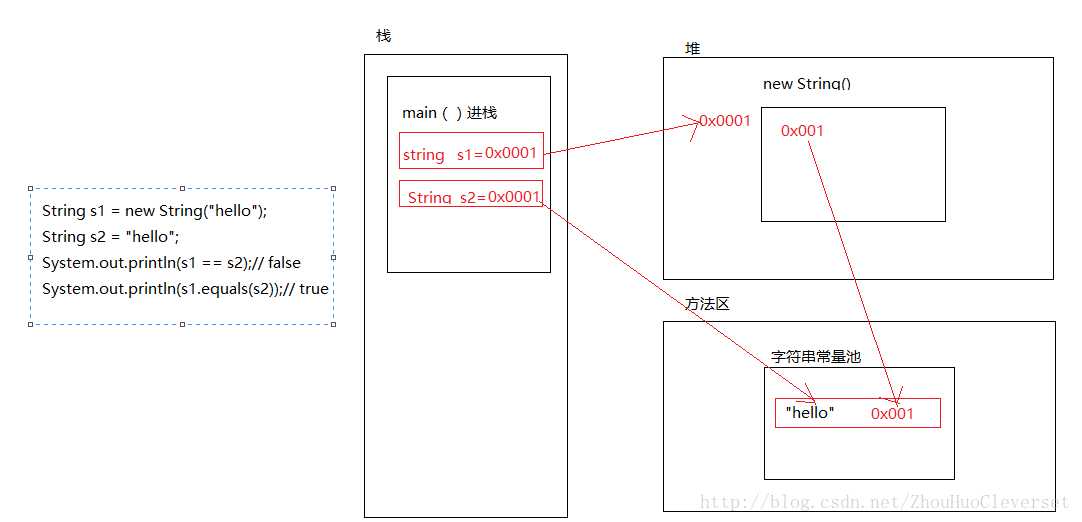标签:默认 equals 之间 The height 字符 stat 分配 解释
百度的面试官问
String A="ABC";
String B=new String("ABC");
这两个值,A,B 是否相等,如果都往HashSet里面放,能放下吗?
答:A==B 不等,但是A.equals(B)相等;因为相等,所以都往HashSet里面放不下,只能放一个
这个问题涉及到常量池的概念,
问:String str=new String("a")和String str = "a"有什么区别?
答:
==与equals()的区别:
String str = "a";内存会去查找永久代(常量池) ,如果没有的话,在永久代中中开辟一块儿内存空间,把地址付给栈指针,如果已经有了"a"的内存,直接把地址赋给栈指针;
因此
String str1="aa";
Srting str2="aa";
String Str3="aa";
....
这样下去,str1==Str2==str3;会一直相等下去,(a) ==的判断, (b) equals()的判断;都相等,因为他们都相等,因此只在常量池中有一份内存空间,地址全部相同;
而String str = new String("a");是根据"a"这个String对象再次构造一个String对象;在堆中从新new一块儿内存,把指针赋给栈指针,
将新构造出来的String对象的引用赋给str。 因此 只要是new String(),则,栈中的地址都是指向最新的new出来的堆中的地址,
(a)“”==“” 是判断地址的,当然不相同;
(b)至于equals,String类型重写了 equals()方法,判断值是否相等,明显相等,因此 equals 是相等的;
这是String 重写的equals:
* @see #compareTo(String) * @see #equalsIgnoreCase(String) */ public boolean equals(Object anObject) { if (this == anObject) { return true; } if (anObject instanceof String) { String anotherString = (String) anObject; int n = value.length; if (n == anotherString.value.length) { char v1[] = value; char v2[] = anotherString.value; int i = 0; while (n-- != 0) { if (v1[i] != v2[i]) return false; i++; } return true; } } return false; }

public class StringDemo2 { public static void main(String[] args) { String s1 = new String("hello"); String s2 = "hello"; System.out.println(s1 == s2);// false System.out.println(s1.equals(s2));// true } } **运行结果:** > false > true
代码详解
public class StringDemo1 { public static void main(String[] args) { String s1 = new String("hello"); String s2 = new String("hello"); System.out.println(s1 == s2);// false System.out.println(s1.equals(s2));// true String s3 = new String("hello"); String s4 = "hello"; System.out.println(s3 == s4);// false System.out.println(s3.equals(s4));// true String s5 = "hello"; String s6 = "hello"; System.out.println(s5 == s6);// true System.out.println(s5.equals(s6));// true } }

s1~s6用equals()的比较不解释,都是比较的值,均为true。以下讲解==
public class StringDemo4 { public static void main(String[] args) { String s1 = "hello"; String s2 = "world"; String s3 = "helloworld"; System.out.println(s3 == s1 + s2);// false System.out.println(s3.equals((s1 + s2)));// true System.out.println(s3 == "hello" + "world");//false System.out.println(s3.equals("hello" + "world"));// true } }

equals()比较方法不解释,比较值,均相等,均为true。
参考:String str=new String("a")和String str = "a"有什么区别?
Java中String直接赋字符串和new String的区别 如String str=new String("a")和String str = "a"有什么区别?
标签:默认 equals 之间 The height 字符 stat 分配 解释
原文地址:https://www.cnblogs.com/aspirant/p/9193112.html